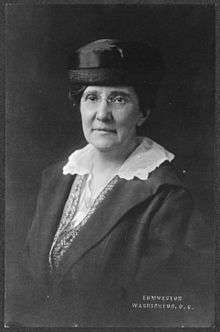Caroline Spencer (suffragist)
| Caroline E. Spencer | |
|---|---|
 | |
| Born |
October 30, 1861 Philadelphia, Pennsylvania, U.S.A. |
| Died | September 16, 1928 (aged 66) |
| Nationality | American |
| Occupation | Physician, activist |
Caroline Spencer (1861–1928) was an American physician and suffragist who campaigned vigorously for women's rights. She was inducted into the Colorado Women's Hall of Fame in 2006.[1]
Early life and education
Caroline E. Spencer was born in 1861 to Anna Brock Spencer (who died when she was 9 years old) and J. Austin Spencer, an attorney from Philadelphia. Spencer was well educated, graduating with honors for scholastic achievement from the Philadelphia Normal School for Girls in 1880.[2]
After teaching for a few years, she enrolled in the Women's Medical College of Pennsylvania and graduated with her medical degree in 1892.[2]
In 1889, Spencer, who was already troubled with bronchitis and asthma, visited Colorado hoping that the climate would be beneficial. Four years later she moved to the state permanently, although she would continue to travel throughout her life. She settled in Colorado Springs, where she lived until 1928, the year of her death.[2]
Activism
In Colorado, Spencer was active in setting up civic and social organizations.[2] She was a founder of the Women’s Club of Colorado Springs (1902) as well as of the Civic League (1909).[1] The Civic League, which championed both women's rights and labor rights, ran afoul of business interests in the state and was eventually forced to close.[2] Its leaders, including Spencer, regrouped under the aegis of a national organization, Alice Paul's militant Congressional Union (later the National Woman's Party).[1] Since Colorado women had gained the vote at the state level in 1893, Spencer and her local allies focused their efforts on legislation at the national level, and especially on passage of the 19th Amendment to the Constitution.[2]
Colorado Springs became the CU/NWP headquarters in the state, and Spencer herself was recognized as an able leader of her state's radical feminist wing.[2] She helped to stage numerous local suffragist publicity events; among other things, Colorado Springs became a stop-off point for cross-country car and train tours known as "Suffrage Specials."[2]
— Caroline Spencer[2]
Spencer also took part in a number of public demonstrations for women's rights.[1] In 1916, she protested speeches by William Jennings Bryan in Colorado and President Woodrow Wilson in Washington, D.C., waving banners that asked what men would do for women's suffrage.[1] Between 1916 and 1919, although she was in frail health, she was a frequent picketer at the White House, for which she was arrested three times and imprisoned twice.[1][2] During one such imprisonment, she suffered such a bad asthma attack in the airless cell that a physician ordered her release.[2] She later received a silver brooch shaped like a prison door that Alice Paul had made for the 90 women who served jail terms for picketing the White House over women's rights.
She died of tuberculosis in 1928.[1] In 2006, her contributions to women's suffrage were recognized by her induction into the Colorado Women's Hall of Fame.